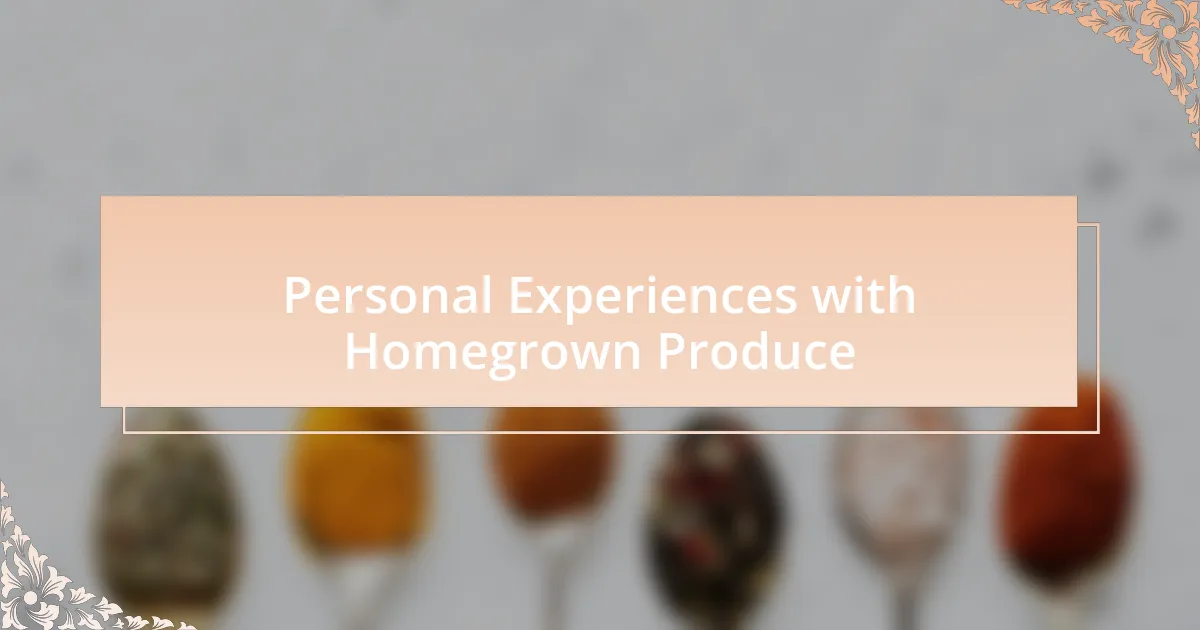Key takeaways:
- Homegrown produce enhances the connection to nature and fosters appreciation for the effort behind each meal.
- Growing your own fruits and vegetables not only improves flavor and nutrition but also provides satisfaction and health benefits by avoiding pesticides.
- Experiences with homegrown ingredients create memorable culinary moments, influencing creative cooking and a joyful dining experience.
- Sourcing local ingredients through farmers’ markets and co-ops fosters community and encourages trying new recipes based on seasonal produce.

Understanding Homegrown Produce
Homegrown produce carries a unique story, one that starts in your own backyard or balcony. I remember the first time I bit into a tomato fresh off the vine; the taste was vibrant and sweet, unlike anything I had ever bought from the store. It made me wonder: how can something so simple create such a profound connection to nature?
When you grow your own fruits and vegetables, you not only witness their life cycle but also cultivate a deeper appreciation for the effort behind each meal. I’ve often felt pride as I tend to my garden, nurturing those little seeds and watching them flourish into something nourishing. It’s fascinating to consider how those moments in the garden lead to flavors that can’t be found in store-bought items.
Understanding homegrown produce also means realizing the environmental impact of your choices. With a little effort, you can reduce your carbon footprint while enjoying fresher ingredients. How gratifying is it to know that you’re contributing to sustainability just by choosing to grow your own food? For me, each harvest represents a step towards a healthier lifestyle and a more sustainable future.

Benefits of Homegrown Produce
Growing your own produce offers a unique blend of flavors and nutrition that often surpasses what you find at the grocery store. I vividly recall biting into a cucumber I had just picked; the crispness and refreshing taste were invigorating. Can you imagine the difference between that and the muted flavor of a store-bought one? This experience highlights the undeniable link between growing your own food and enjoying a richer culinary experience.
Another striking benefit is the unparalleled satisfaction that comes with nurturing your plants from seed to harvest. One particularly summer afternoon, I spent hours in my garden, only to reap a bountiful harvest of peppers. The joy of knowing that my care and patience directly resulted in that delicious meal truly enhanced my appreciation for homegrown food. Isn’t it interesting how that simple act instills a profound sense of accomplishment?
Moreover, homegrown produce tends to be free from pesticides and chemicals, adding an extra layer of health benefits. I remember the relief I felt when I learned that the kale I was using for my brunch was completely organic—grown right in my backyard, without any harmful treatments. Doesn’t it feel good to know what you’re consuming? By choosing to grow my own food, I not only support my health but also ensure that my meals are as wholesome as possible.

Integrating Produce into Brunch Menus
Integrating fresh produce into brunch menus can redefine the dining experience, emphasizing the joy of seasonal ingredients. Last summer, I crafted a vibrant tomato and basil salad that mirrored the colors of a sunset. The burst of flavors was a testament to the quality of the tomatoes I had picked just hours prior—who would have thought that fresh ingredients could elevate a simple dish so profoundly?
Another approach I love is incorporating herbs and greens into brunch beverages. I once experimented with a refreshing mint-infused lemonade, using mint from my garden. The added dimension was remarkable; it transformed an ordinary drink into a memorable feature of the meal. Can you think of how fresh herbs could jazz up your favorite brunch cocktails?
Lastly, I’m a firm believer in the power of showcasing vegetables through creative brunch options. One weekend, I whipped up a frittata loaded with zucchini, mushrooms, and bell peppers straight from my backyard. The first bite was pure delight! How fantastic is it to savor a dish where you can literally taste the love and effort from your own garden? Integrating homegrown produce truly connects us to our food and enhances the overall dining experience.

Creative Brunch Recipes with Produce
One creative way I’ve been experimenting is by making savory pancakes loaded with freshly grated zucchini and scallions. The first time I served these at brunch, the aroma filled the kitchen, drawing everyone in. Each bite was a delightful mix of flavors, and I couldn’t help but smile as friends went back for seconds—it’s amazing how something so simple can spark such joy.
Another recipe that never fails to impress is my roasted vegetable and quinoa bowl. I often use whatever’s fresh from my garden, like sweet potatoes and vibrant bell peppers. It’s not just about the taste; it’s about the colors and textures that make the dish visually stunning. Have you ever noticed how a burst of color on your plate can brighten your mood?
Lastly, I’ve found that incorporating fruit into brunch can lead to some delicious surprises. For instance, last fall, I prepared a creamy ricotta toast topped with figs and a drizzle of honey. The sweetness paired with the creaminess was heavenly! It made me think—how often do we neglect the beauty and flavor that fruit can bring to our brunch offerings?

Tips for Sourcing Local Ingredients
When it comes to sourcing local ingredients, I’ve found farmers’ markets to be a treasure trove of fresh produce. I remember one sunny Saturday discovering heirloom tomatoes that were bursting with flavor and color. Have you ever tasted a tomato right off the vine? It’s a game changer. Not only do these markets support local farmers, but they also foster a sense of community that feels so rewarding.
Join a local co-op or farm share program if you have the chance. My experience with this has been enlightening; every week, I receive a box of seasonal goodies that inspire my cooking. It’s like a surprise that keeps on giving—each box challenges me to try new recipes and think outside my usual brunch menu. Isn’t it exciting to let the ingredients dictate your creativity in the kitchen?
Don’t underestimate the power of social media in connecting with local producers. I’ve discovered amazing bakeries, dairy farms, and specialty stores through Instagram and Facebook. It’s fascinating how a simple scroll can lead to a local grain mill whose flours made my recent pancakes something exceptionally special. Aren’t we fortunate to live in an age where we can connect so easily with those who are passionate about what they grow?

Personal Experiences with Homegrown Produce
One summer, I decided to grow my own herbs in a small container garden on my balcony. The aroma of fresh basil, mint, and rosemary wafting through my kitchen was unlike anything from the grocery store. Have you ever snipped a few leaves off your own plants to add to a dish? It felt like a personal touch that elevated my cooking to a new level.
I also recall the excitement of harvesting perfectly ripe strawberries. The moment I took a bite, the burst of sweetness was a reminder of childhood summers spent berry-picking. It made me realize that homegrown produce isn’t just food; it’s an experience, a connection to nature that brings joy to every meal we create.
One of my favorite brunch dishes features my homegrown avocados, which taste infinitely better than any store-bought version. I often wonder why it took me so long to appreciate this simple pleasure. Using fresh ingredients that I’ve nurtured gives me a sense of pride and ownership in my cooking, showing me just how rewarding home gardening can be in relation to my culinary adventures.

Key Takeaways from My Journey
One key takeaway from my journey with homegrown produce is the profound connection it fosters between the gardener and the food. I remember the first time I carefully unraveled the roots of a tiny tomato seedling I had planted months earlier. That moment made me realize how much love and patience go into growing our food. Have you ever felt such a tangible connection to what you eat? It’s a unique bond that certainly adds depth to your meals.
Another insight has been the sense of adventure that comes with experimenting in the garden. There was a time when I decided to try growing peppers of various colors and heat levels, only to discover my taste for spicy food had grown alongside them. The thrill of tasting those first fiery bites was exhilarating. It taught me that growing your own produce pushes you to expand your culinary boundaries and redefine your palate. How can we truly know what we love if we don’t embrace the unexpected?
Lastly, I’ve discovered that joy can come from the simplest act of nurturing. Watching a seed grow into a flourishing plant is a daily reminder of resilience and potential, much like our lives. The days when I simply stepped outside to tend to my garden provided me solace and grounding after a hectic week. Isn’t it incredible how something as simple as tending to plants can teach us invaluable lessons about patience and the rewards of hard work?